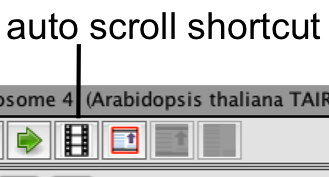Moving
...
left to right, or up and down in IGB
IGB has multiple different methods to allow you to move around and explore your data. Each method has it's own advantages, so be sure to try them all out.
Scroll Bar
...
Horizontal scroller
Use the horizontal scroller to move the display from left to right. The image below shows the horizontal scroll barscrollbar, with directional arrows at the end. The scroll bar is used by clicking on the 'thumb' in the scroll bar and dragging it to the left or right To use the scroller, click-drag the thumb (see red arrow and red box) . One note about the scroll bar is that it moves a defined number of pixels, irrespective of zoom level; i.e. at very high zoom (zoomed in), using the scroll bar will send you 'flying' through your data, and move it left or right. Note however that when you are zoomed in, scrolling moves the display very quickly and you may lose track of the area region you were looking at. On the other hand, this is the fastest method of movement at lower zoom levels (zoomed out).Clicking and holding on either arrow at the end of the scroll bar will allow for slow movement of the image in the direction of the arrow (viewing. The horizontal scroller works best when you're zoomed out on large regions.
To move short distances, click the icons on the right side of the scroller - see blue arrow and blue box). This is the slowest method of moving through the image, although it can be useful at the highest zoom levels (zoomed in).
Click-
...
drag to move left or right
Click-drag the selection tool (see red box below) to move in a more controlled fashion through the data. To use the click-drag, you use the 'pointer' cursor. Click Choose the selection tool and then click anywhere near the edge of the image, and while . Keep the mouse button is depressed, pressed and drag the cursor to the edge of the image; as the cursor gets to the edge of the image, the image will begin scrolling in the opposite direction (see image below)(arrow) to the left or right. This click-drag movement is reminiscent of the scrolling movement seen interaction is similar to how you can scroll up or down in many word processing programs, where you can select text and then drag the cursor is used to select text and scroll/select further into up or down to scroll through the document.
Grab-Drag
This a new feature as of debuted in IGB 6.5. Here, you select the 'hand' cursor, by clicking the 'hand' box. You click the cursor in the image ('grab'), and you 'drag' the image grab tool ("cartoon hand") and then use it to drag the display in the direction you want it to move. This allows the image and the cursor to move in the same direction (the opposite of click-drag method) (see image below). 'hand' box.
Note: After moving to an area of interest, you will need to change back to the Select cursor (arrow button to the left of the Grab button) in order to select annotations or elements within the image.
Autoscroll
This is a very useful feature for moving through images of large data sets. scanning large regions at medium zoom levels.
You can set the speed of movement in the window (see image below), and IGB will move through the image, from left to right, at a set speed. Autoscroll can be accessed through the View menu. The Autoscroll function has the option to set a keyboard shortcut for it; go to File > Preferences > Shortcuts. A shortcut key will allow you to start and stop the autscrolling from a simple key stroke.
Resolution reflects the zoom level of the image. This can be set by hand, or just left 'as is' if you have already gone to the zoom level you prefer. Scroll increment is how far it shifts the image each time it moves; Time interval is how fast the image moves. These three elements work together to affect the speed at which you see data move past. We recommend setting the zoom level based on the image, then adjust the time or scroll until it is moving at a level comfortable for you. Megabases per minute and Total minutes for seq. will give you an idea of the final Autoscroll speed.
Note: You can designate a keyboard shortcut to activate or halt autoscrolling; go to File > Preferences > Shortcuts. Setting a shortcut key will allow you to start and stop the autoscrolling quickly and easily.
